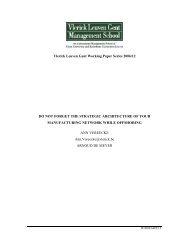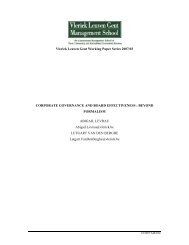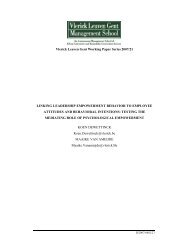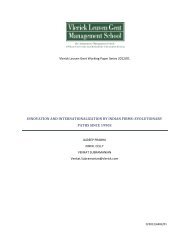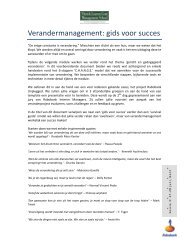an experimental investigation of the interactions ... - Vlerick Public
an experimental investigation of the interactions ... - Vlerick Public
an experimental investigation of the interactions ... - Vlerick Public
You also want an ePaper? Increase the reach of your titles
YUMPU automatically turns print PDFs into web optimized ePapers that Google loves.
Researchers in psychology have paid enormous attention to <strong>the</strong> influence <strong>of</strong> descriptivesocial norms on behavior <strong>of</strong> individuals. Asch (1951), for inst<strong>an</strong>ce, shows that individuals agree with<strong>the</strong> wrong <strong>an</strong>swers <strong>of</strong> <strong>the</strong> o<strong>the</strong>r members <strong>of</strong> <strong>the</strong>ir group <strong>an</strong>d that this effect is streng<strong>the</strong>ned when<strong>the</strong> o<strong>the</strong>r group members are un<strong>an</strong>imous <strong>an</strong>d show greater discomfort with deviations from <strong>the</strong>irun<strong>an</strong>imous <strong>an</strong>swer. In a more recent study, Goldstein et al. (2008) finds that hotel guests complymore with <strong>the</strong> towel-reuse rate <strong>of</strong> <strong>the</strong> o<strong>the</strong>r hotel guests who had previously stayed in <strong>the</strong>ir roomth<strong>an</strong> with <strong>the</strong> towel-reuse rates <strong>of</strong> reference groups that are considered to be import<strong>an</strong>t <strong>an</strong>dpersonally me<strong>an</strong>ingful to <strong>the</strong> hotel guests. Also <strong>an</strong>alytical researchers have begun to incorporatesocial norms in <strong>the</strong>ir models <strong>an</strong>d find that behavior deviates from <strong>the</strong> behavior that c<strong>an</strong> be expectedwithout incorporating <strong>the</strong> social norms (Fisher <strong>an</strong>d Huddart 2008).Previous research has been inconclusive about <strong>the</strong> import<strong>an</strong>ce <strong>of</strong> <strong>the</strong> economic structure<strong>an</strong>d <strong>the</strong> descriptive social norms for employee decisions. Maltz <strong>an</strong>d Kohli (1996), for inst<strong>an</strong>ce, findsthat formal mech<strong>an</strong>isms are more import<strong>an</strong>t th<strong>an</strong> <strong>the</strong> descriptive social norms in directing employeedecisions, while An<strong>an</strong>d et al. (2009) <strong>an</strong>d Cousins et al. (2009) observe that <strong>the</strong> reverse is true. Priorstudies <strong>of</strong>ten consider formal mech<strong>an</strong>isms as one coherent construct or assume that different formalmech<strong>an</strong>isms are always aligned with <strong>the</strong> firm’s best interest (Doerr et al. 1996). Thus, prior studiesfail to incorporate that combinations <strong>of</strong> formal mech<strong>an</strong>isms c<strong>an</strong> be ei<strong>the</strong>r aligned or misaligned,which is <strong>an</strong> import<strong>an</strong>t characteristic <strong>of</strong> combinations <strong>of</strong> formal mech<strong>an</strong>isms (Roberts 2004).We predict <strong>an</strong> interactive effect between combinations <strong>of</strong> formal mech<strong>an</strong>isms <strong>an</strong>ddescriptive social norms. Recall that misaligned combinations <strong>of</strong> formal mech<strong>an</strong>isms provideemployees with mixed cues about how <strong>the</strong>y are expected to behave. In o<strong>the</strong>r words, misalignedcombinations <strong>of</strong> formal mech<strong>an</strong>isms lead to <strong>an</strong> ambiguous situation. Theory in social psychologyposits that individuals are most likely to use <strong>the</strong> evidence <strong>of</strong> o<strong>the</strong>r’s behavior to decide about <strong>the</strong>most effective course <strong>of</strong> action when <strong>the</strong> situation is novel, ambiguous or uncertain (Cialdini <strong>an</strong>dTrost 1998; Sherif <strong>an</strong>d Murphy 1936; Deutsch <strong>an</strong>d Gerrard 1955). Fur<strong>the</strong>rmore, <strong>an</strong> import<strong>an</strong>tpostulate <strong>of</strong> <strong>the</strong> focus <strong>the</strong>ory <strong>of</strong> normative conduct is that norms are likely to influence behaviordirectly to <strong>the</strong> extent that it is salient (Cialdini et al. 1990; Goldstein <strong>an</strong>d Cialdini 2010; Kallgren et al.2000). Accordingly, misaligned combinations <strong>of</strong> formal mech<strong>an</strong>isms will lead to ambiguity that willmake <strong>the</strong> firm’s descriptive social norms a more salient source <strong>of</strong> information. Therefore, we expectthat <strong>the</strong> influence <strong>of</strong> descriptive social norms on employee decision-making will be larger whencombinations <strong>of</strong> formal mech<strong>an</strong>isms are misaligned compared to aligned combinations <strong>of</strong> formalmech<strong>an</strong>isms.10



